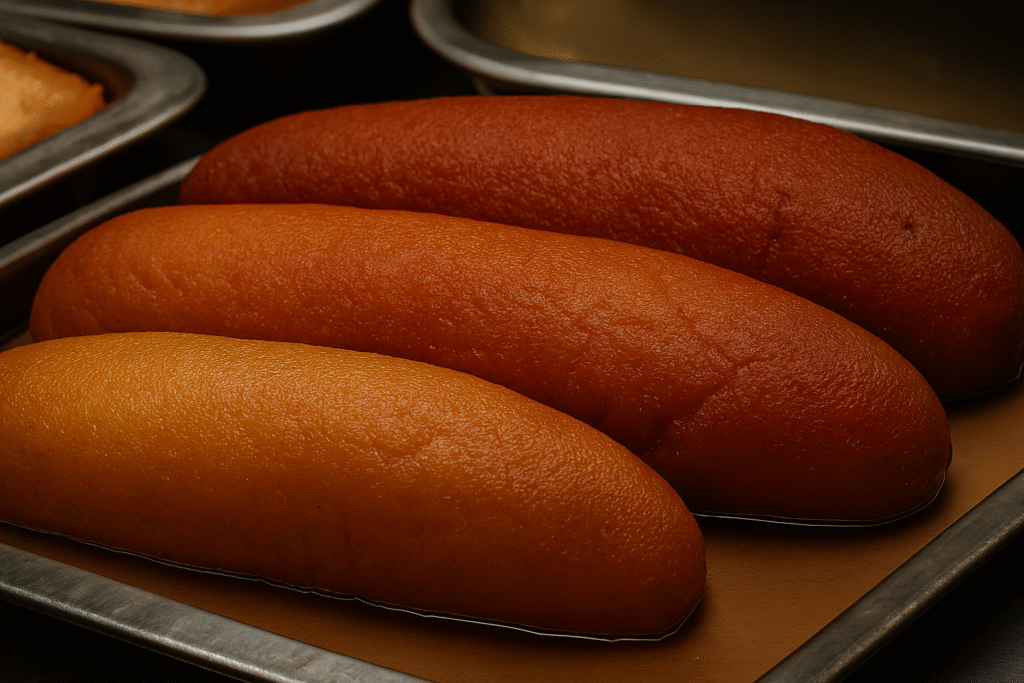What Is Balish Mishti?
The iconic Balish Mishti of Netrokona has officially been recognized as a Geographical Indication (GI) product, elevating this soft, pillow-shaped sweet into Bangladesh’s recognized heritage list. This recognition not only secures legal protection for the product but also underscores its deep cultural roots and century-long legacy in Netrokona’s culinary tradition.
Balish Mishti, translated as “pillow sweet,” is a distinctive confection crafted from curd (chhena), flour, and sugar, then finished with a topping of thickened milk (malai). Its soft texture and gentle sweetness, combined with a creamy malai coat, make it unlike typical sweets like sandesh or rasgulla. The sweet’s name derives from its pillow-like shape, often sold in sizes meant for sharing during celebrations.
Local confectioners in Netrokona’s Barhatta Road, especially at Goyanath Mishtanno Bhandar, remain custodians of its traditional recipe, passed down through generations. The Ghosh family originally created it over a century ago, and the current owners — the Modak family — continue the same legacy.
GI Tag: What It Means
By granting Balish Mishti GI status, the Department of Patents, Designs and Trademarks (DPDT) formally recognizes that this sweet is uniquely tied to its geographic origin and traditional production method. GI status helps protect the name against misuse, ensures quality control, and can boost market value and prestige.
Netrokona’s DC, Mohammad Abdullah Al Mahmud Zaman, confirmed that while the GI approval is granted, the official certificate is still pending delivery. He emphasized that Balish is now “synonymous with Netrokona” and that this recognition strengthens the district’s branding.
Balish Mishti now joins Bijoypur white clay — another GI product from Netrokona — strengthening the district’s portfolio of regionally unique products.
History, Production, and Secrecy
The origins of Balish Mishti trace back to the confectioner Goyanath Ghosh, who created the sweet in Netrokona more than 120 years ago. Even during the turbulent times of Partition, the sweet stayed in Netrokona, preserved by local artisans.
The production process is partly guarded as a trade secret by the Goyanath (later Modak) family. The core recipe involves curdled milk mixed with a bit of flour, molded into pillow shapes, fried, soaked in hot sugar syrup, and finally coated with malai. Their unique technique and the quality of ingredients are what make Balish Mishti distinct.
Prices vary based on size — small ones are sold at Tk 30, 50, or 100; the larger “Balish” (sometimes for sharing) can cost Tk 300, 500, or even Tk 1,000. The sweet’s demand swells during festivals, weddings, and local fairs, making it not just a treat, but a symbol of cultural identity.
Significance for Netrokona & Beyond
The GI status for Balish Mishti is more than just a legal badge: it is a badge of pride for Netrokona. For the local community, it protects artisan livelihoods and prevents imitation products from diluting the brand.
Tourists and visitors often buy Balish as souvenirs, helping spread awareness. Over the years, people outside Netrokona have carried boxes of Balish as tokens of cultural identity. With GI status, such purchases now carry greater legitimacy.
The recognition also encourages local producers to maintain quality and authenticity, which can open doors to new markets — possibly even exports, if carefully managed. GI branding can raise shelf appeal and value.
Challenges Ahead
With recognition come responsibilities. The producers of Balish Mishti will need to maintain standards, transparency, and consistency. GI status sometimes requires monitoring of production zones, ingredient sourcing, and adherence to specifications.
Raw material costs — milk, sugar, flour — have already pushed prices higher. Many locals note that Balish, once more affordable, now commands a premium price to sustain production viability.
Also, the GI certificate itself is yet to be officially delivered. Once that is in hand, the legal power of the protection will fully activate.
Cultural Legacy & Community Voice
Balish Mishti is woven into local folklore, songs, and traditions. Poets and folk artists have honored it in rhymes, and the tradition continues in households and festivals.
In local lore, one rhyme goes: “Cash money doesn’t work, / Nor do oil massages, / The boss is pleased only with Netrokona’s Balish.”
This cultural embedding helps Balish Mishti stand out as more than a mere sweet—it is a piece of identity.
Future Prospects & Expansion
Now that Balish Mishti has GI status, stakeholders hope to expand its reach beyond Netrokona. Efforts could include branded packaging, regulated outlets, training new artisans, and perhaps even limited exports.
Netrokona district officials have expressed their intent to nominate more traditional products for GI recognition, building the district’s reputation as a hub of heritage goods.
If managed well, Balish Mishti could inspire similar success for regional sweets across Bangladesh — encouraging cultural preservation and local economies.
The recognition of Balish Mishti as a Geographical Indication product marks a milestone for Netrokona, for Bangladeshi culinary heritage, and for the artisan community behind this century-old sweet. Balish has moved from a local delicacy to a national treasure.
As GI protection takes effect, the challenge it faces is in preserving authenticity, improving production scale, and leveraging its newfound status for sustainable growth. With its rooted legacy, cultural resonance, and now formal protection, Balish Mishti is poised to charm both connoisseurs and cultural custodians across Bangladesh and beyond.
